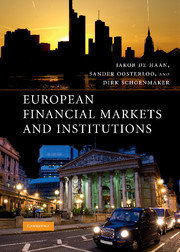Book contents
- Frontmatter
- Contents
- List of Boxes
- List of Figures
- List of Tables
- List of Countries
- List of Abbreviations
- Preface
- Part I Setting the Stage
- Part II Financial Markets
- Part III Financial Institutions
- 6 The Role of Institutional Investors
- 7 European Banks
- 8 The Financial System of the New Member States
- 9 European Insurers and Financial Conglomerates
- Part IV Policies for the Financial Sector
- Index
- References
8 - The Financial System of the New Member States
from Part III - Financial Institutions
- Frontmatter
- Contents
- List of Boxes
- List of Figures
- List of Tables
- List of Countries
- List of Abbreviations
- Preface
- Part I Setting the Stage
- Part II Financial Markets
- Part III Financial Institutions
- 6 The Role of Institutional Investors
- 7 European Banks
- 8 The Financial System of the New Member States
- 9 European Insurers and Financial Conglomerates
- Part IV Policies for the Financial Sector
- Index
- References
Summary
OVERVIEW
This chapter discusses the financial structure of the new Member States of the European Union. It starts by analysing the importance of financial markets and financial institutions in financing investment in the NMS. Stock-market capitalisation in various NMS has increased, but its level in the NMS is still far below that in the EU-15. By far the most important category of financial institutions in the NMS are banks; the role of insurance companies, investment funds, and pension funds in the NMS is still underdeveloped in comparison with the EU-15. The chapter describes the banking sector in the NMS in some detail. This sector is generally highly concentrated. Foreign bank presence is very large in most NMS, mainly in the form of subsidiaries of foreign banks.
Since the banking sector in the NMS is strongly dominated by foreign banks, this chapter also examines the determinants of foreign bank entry. Next to this, the considerations for a particular way of foreign bank entry (greenfield investment or acquisition) as well as the organisational form of representation (representative office, agency, branch, or subsidiary) are discussed.
The final part of the chapter analyses how beneficial financial integration has been for the economic development of the NMS. Some recent studies conclude that the ongoing global financial integration may have had little or no value in advancing economic growth, especially in less developed countries. Capital is often found to flow ‘uphill’, i.e., from less developed to industrial countries.
- Type
- Chapter
- Information
- European Financial Markets and Institutions , pp. 236 - 258Publisher: Cambridge University PressPrint publication year: 2009



